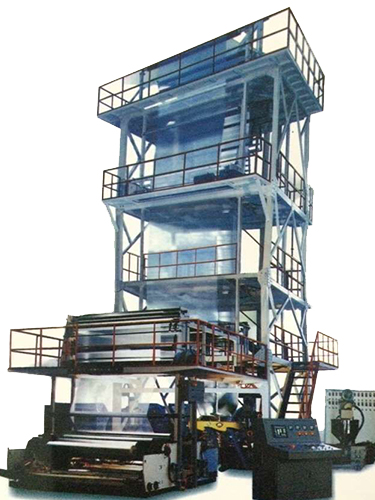Dalian Youyan Plastic Machinery Co., Ltd.
Couplet: Feng Manager
Phone/fax:086-0411-86260347
Hand:18624289888
13604263838
Mail box:21272059@qq.com
Network access:www.dlyouyan.com
Address: Chinese Lushunkou District of Dalian City, the three streams town (take Tuchengzi Dalian to Lushun Road westbound vehicle airport about 200 meters in front of about 100 meters)
The three-layer co extrusion blown film machine, as an efficient and multifunctional plastic film production equipment, plays an important role in modern industrial production. Its unique three-layer co extrusion technology can produce high-performance multi-layer composite films, which are widely used in packaging, agriculture, medical, construction and other fields. With the continuous growth of market demand and technological progress, the development prospects of three-layer co extrusion blown film machines are very broad, which will provide higher quality products and solutions for related industries.
The three-layer co extrusion blown film machine can produce composite films with multi-layer structures, and each layer of material can be optimized and combined according to application requirements to meet different performance requirements. By combining different materials, films can have excellent barrier properties, heat resistance, mechanical strength, weather resistance, and other properties, meeting the needs of various complex application scenarios.
How to solve common faults of three-layer co extrusion blown film machine?
The film has wrinkles and folds
reason
The uneven pressure on both sides of the traction roller results in an unbalanced force on the film.
The uneven airflow of the cooling air ring causes uneven cooling and shrinkage of the film.
The uneven thickness of the film is prone to wrinkling during the traction process.
The winding tension is unstable, sometimes high and sometimes low, causing wrinkles and folds in the film during the winding process.
solution
Adjust the pressure on both sides of the traction roller to make it uniform and consistent, which can be detected and adjusted through pressure sensors or pressure gauges.
Check the air outlet of the cooling air ring, clean any blockages, and ensure even air flow. If necessary, adjust the position or angle of the air ring to ensure even cooling of the film.
Referring to the method mentioned earlier to solve uneven film thickness, adjust parameters such as die discharge, inflation ratio, and traction ratio to make the film thickness uniform.
Install tension control system to stabilize the winding tension. At the same time, check the transmission components of the winding mechanism, such as gears, chains, belts, etc., to ensure smooth transmission without looseness or slipping.
film blocking
reason
The cooling effect is poor, and the temperature of the film is too high during winding, leading to adhesion.
The influence of additives in raw materials, such as insufficient or poor quality of lubricants, anti adhesion agents, etc.
The environmental humidity is high, and the surface of the film adsorbs moisture, which can easily cause adhesion.
solution
Strengthen the cooling effect of the cooling system, increase the cooling air volume, reduce the cooling air temperature, or optimize the flow direction of the cooling air. At the same time, reduce the production speed appropriately to allow sufficient time for the film to cool down.
Check the amount of additives added to the raw materials and accurately add lubricants, anti adhesion agents, etc. according to the process requirements. If the quality of additives is found to be poor, replace them with high-quality products in a timely manner.
To control the humidity in the production environment, dehumidification equipment can be installed in the workshop to keep the humidity within an appropriate range. For films that have already adhered, you can try placing them in a low-temperature, low humidity environment for a period of time to see if they can separate.
The extruder discharge is not smooth
reason
The bridging of raw materials in the hopper prevents them from smoothly entering the screw.
The screw is severely worn and the gap between it and the material barrel is too large, which affects the material transportation.
The filter screen is clogged, causing an increase in the flow resistance of the melt.
Heating system malfunction resulting in poor plasticization of raw materials.
solution
To clean the bridging materials in the hopper, a mixing device or vibrator can be installed on the hopper to prevent the materials from bridging.
Check the wear of the screw and barrel. If the wear is severe, replace the screw or repair the barrel in a timely manner. At the same time, adjust the gap between the screw and the barrel to meet the equipment requirements.
Regularly replace the filter screen and determine the replacement cycle based on production conditions. When replacing the filter, thoroughly clean the filter bracket and surrounding impurities.
Check the heating elements, temperature controllers, etc. of the heating system, and replace them promptly if they are damaged. At the same time, according to the characteristics of the raw materials and process requirements, adjust the heating temperature and insulation time to ensure good plasticization of the raw materials.
The three-layer co extrusion blown film machine can produce film products with various properties, such as high barrier, heat resistance, tear resistance, etc., by adjusting the combination of different plastic raw materials. The three-layer co extrusion technology can reduce the use of expensive materials while ensuring the performance of the film, thereby lowering production costs. The three-layer co extrusion blown film machine can simultaneously extrude three types of plastic raw materials, greatly improving production efficiency.
Three layer co extruded film can combine the characteristics of different materials, such as barrier properties, heat resistance, mechanical strength, etc., and is widely used in fields such as food packaging, pharmaceutical packaging, and daily necessities packaging. For example, using wear-resistant materials for the outer layer, barrier materials for the middle layer, and food grade materials for the inner layer can meet the packaging's requirements for strength, barrier properties, and hygiene.

